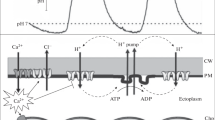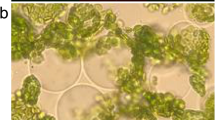Summary
The current-voltage (I/V) and conductance-voltage (G/ V) characteristics were recorded for intact and perfused (tonoplast-free) cells ofNitellopsis obtusa. In the pH0 range 5 to 8, the I/V profile was sigmoidal and the G/V profile exhibited a maximum — these characteristics are attributed to the proton pump at the plasmalemma. The pH0 dependence in this range was very similar to that found inChara corallina. At very alkaline pH0 (11.0) the high conductance due to H+/OH− channels was observed in intact cells but not in perfused cells. Young plants ofNitellopsis did not display bands of calcification, but did exhibit pH banding patterns in petri dishes. The pH bands were less than 5mm wide. The excitation transients in intact cells featured two peaks near the excitation threshold, but more peaks could be observed in the p.d. (potential difference) range −90 to −60 mV. The amplitude of the transients was strongly inhibited at pH0 11.0. In the perfused cells the currents lacked complete inhibition at some p.d. levels, but still exhibited one or two peaks. At high pH0 this lack of inactivation was accentuated. The addition of 5 mM TEA to the outside medium abolished the excitation transients in perfused cells.
Similar content being viewed by others
Abbreviations
- EGTA:
-
ethylene glycol-bis (β-amino-ethylether)-N,N′-tetraacetic acid
- PIPES:
-
piperazine-N,N′-bis-(2-ethane sulfonic acid)
- TEA:
-
tetraethyl ammonium
References
Azimov RR, Geletyuk VI, Berestovskii GN (1987) Single potential-dependent K+ channel of the cells of the algaNitellopsis obtusa. Biophysics 32: 82–88
Beilby MJ (1984) Current-voltage characteristics of the proton pump atChara plasmalemma: I. pH dependence. J Membr Biol 81: 113–125
— (1989) Electrophysiology of giant algal cells. In: Fleischer S, Fleischer B (eds) Methods in enzymology, vol 174. Academic Press, San Diego, pp 403–443
— (1990) Current-voltage curves for plant membrane studies: a critical analysis of the method. J Exp Bot 41: 165–182
—, Beilby BN (1983) Potential dependence of the admittance ofChara plasmalemma. J Membr Biol 74: 229–245
—, Bisson MA (1992)Chara plasmalemma at high pH: voltage dependence of the conductance at rest and during excitation. J Membr Biol 125: 23–29
—, Coster HGL (1979) The action potential inChara corallina. II. Two activation-inactivation transients in voltage clamps of the plasmalemma. Aust J Plant Physiol 6: 323–35
Bisson MA, Walker NA (1980) TheChara plasmalemma at high pH. Electrical measurements show rapid specific passive uniport of H+ or OH−. J Membr Biol 56: 1–7
Blatt MR (1991) Ion channel gating in plants: physiological implications and integration for stomatal function. J Membr Biol 124: 95–112
Findlay GP (1970) Membrane electrical behavior inNitellopsis obtusa. Aust J Biol Sci 23: 1033–45
Geynes M, Bulychev AA, Kurella GA (1980) Voltage clamp studies on the slow inward current during the excitation ofNitellopsis obtusa. J Exp Bot 31: 589–595
Kataev AA, Zherelova OM, Berestovsky GN (1984) Ca2+-induced activation and irreversible inactivation of chloride channels in the perfused plasmalemma ofNitellopsis obtusa. Gen Physiol Biophys 3: 447–462
Katsuhara M, Tazawa M (1990) Mechanism of calcium-dependent salt tolerance in cells ofNitellopsis obtusa: role of intracellular adenine nucleotides. Plant Cell Environ 13: 179–184
—, Mimura T, Tazawa M (1990) ATP-regulated ion channels in the plasma membrane of a Characeae alga,Nitellopsis obtusa. Plant Physiol 93: 343–346
Kikuyama M, Oda K, Shimmen T, Hayama T, Tazawa M (1984) Potassium and chloride effluxes during excitation of Characeae cells. Plant Cell Physiol 25: 965–974
Lucas WJ (1982) Mechanism of acquisition of exogenous bicarbonate by internodal cells ofChara corallina. Planta 156: 181–192
— (1985) Bicarbonate utilization byChara: a reanalysis. In: Lucas WJ, Berry JA (eds) Inorganic carbon uptake by aquatic photosynthetic organisms. American Society of Plant Physiologists, Rockville, MD, pp 223–254
—, Shimmen T (1981) Intracellular perfusion and cell centrifugation studies on plasmalemma transport processes inChara corallina. J Membr Biol 58: 227–237
Lunevsky VZ, Zherelova OM, Vorstrikov IY, Berestovskii GN (1983) Excitation of Characeae cell membranes as a result of activation of calcium and chloride channels. J Membr Biol 72: 43–58
Miedema H, Felle H, Prins HBA (1992) Effect of high pH on the plasma membrane potential and conductance inElodea densa. J Membr Biol 128: 63–69
Mimura T, Shimmen T, Tazawa M (1983) Dependence of the membrane potential on intracellular ATP concentration in tonoplast-free cells ofNitellopsis obtusa. Planta 157: 97–104
— — — (1984) Adenine-nucleotide levels and metabolism-dependent membrane potential in cells ofNitellopsis obtusa Groves. Planta 162: 77–84
Shiina T, Tazawa M (1987 a) Ca2+-activated Cl− channel in plasmalemma ofNitellopsis obtusa. J Membr Biol 99: 137–146
— — (1987 b) Demonstration and characterization of Ca2+ channel in tonoplast-free cells ofNitellopsis obtusa. J Membr Biol 96: 263–276
— — (1988) Ca2+-dependent Cl− efflux in tonoplast-free cells ofNitellopsis obtusa. J Membr Biol 106: 135–139
Shimmen T, Tazawa M (1977) Control of membrane potential and excitability ofChara cells with ATP and Mg2+. J Membr Biol 37: 167–192
— — (1983) Activation of K+ channel in membrane excitation ofNitella axilliformis. Plant Cell Physiol 24: 1511–1524
Spear DG, Barr JK, Barr CE (1969) Localization of hydrogen ion and chloride fluxes inNitella. J Gen Physiol 54: 397–414
Takeshige K, Shimmen T, Tazawa M (1986) Quantitative analysis of ATP-dependent H+ efflux and pump current driven by an electrogenic pump inNitellopsis obtusa. Plant Cell Physiol 27: 337–348
Tazawa M, Shimmen T (1982) Artificial control of cytoplasmic pH and its bearing on cytoplasmic streaming, electrogenesis and excitability of Characeae cells. Bot Mag Tokyo 95: 147–154
Thiel G, MacRobbie EAC, Blatt MR (1992) Membrane transport in stomatal guard cells. the importance of voltage control. J Membr Biol 126: 1–18
- Homann U, Gradmann D (1993) Microscopic elements of electrical excitation inChara: transient activity of Cl− channels in the plasma membrane. J Membr Biol (in press)
Yao X, Bisson MA, Brzezicki LJ (1992) ATP-driven proton pumping in two species ofChara differing in salt tolerance. Plant Cell Environ 15: 199–210
Walker NA, Smith FA, Cathers IR (1980) Bicarbonate assimilation by freshwater charophytes and higher plants: I. membrane transport of bicarbonate ions is not proven. J Membr Biol 57: 51–58
Author information
Authors and Affiliations
Rights and permissions
About this article
Cite this article
Beilby, M.J., Mimura, T. & Shimmen, T. The proton pump, high pH channels, and excitation: voltage clamp studies of intact and perfused cells ofNitellopsis obtusa . Protoplasma 175, 144–152 (1993). https://doi.org/10.1007/BF01385013
Received:
Accepted:
Issue Date:
DOI: https://doi.org/10.1007/BF01385013




